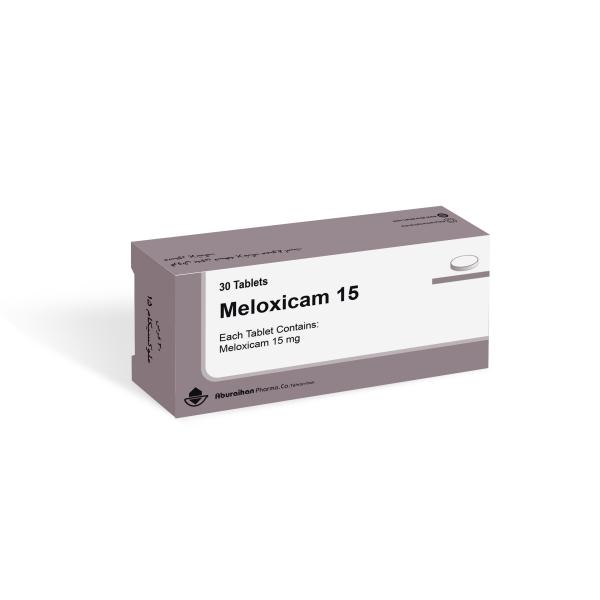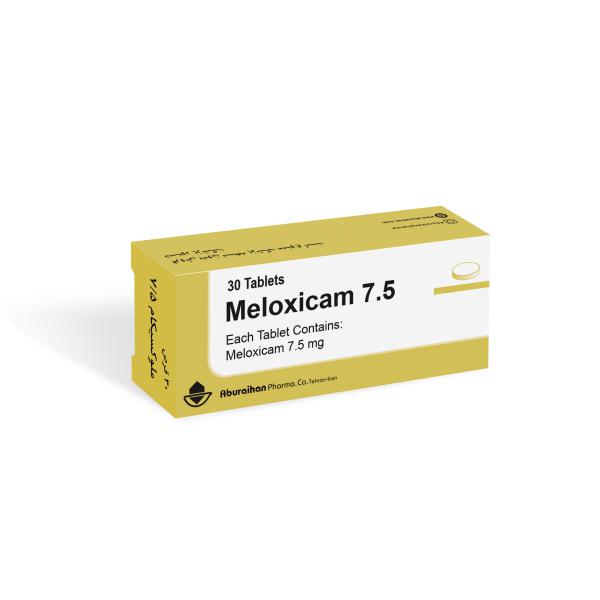Meloxicam
Meloxicam
tablet
Acute Pain, Osteoarthritis, Rheumatoid arthritis
Mechanism of Action:
Reversibly inhibits cyclooxygenase-1 and 2 (COX-1 and 2) enzymes, which results in decreased formation of prostaglandin precursors; has antipyretic, analgesic, and anti-inflammatory properties.
Method of Administration:
Initial: 7.5 mg once daily; may increase to a maximum of 15 mg once daily.
Notes
Contraindications:
Hypersensitivity to meloxicam or any component of the formulation; history of asthma, urticaria, or other allergic-type reactions after taking aspirin or other nonsteroidal anti-inflammatory drugs; use in the setting of coronary artery bypass graft surgery.
Interactions:
Aminoglycosides: Nonsteroidal Anti-Inflammatory Agents may decrease the excretion of Aminoglycosides. Data only in premature infants. Risk C: Monitor therapy
Angiotensin II Receptor Blockers: May enhance the adverse/toxic effect of Nonsteroidal Anti-Inflammatory Agents. Specifically, the combination may result in a significant decrease in renal function. Nonsteroidal Anti-Inflammatory Agents may diminish the therapeutic effect of Angiotensin II Receptor Blockers. The combination of these two agents may also significantly decrease glomerular filtration and renal function. Risk C: Monitor therapy
Apixaban: Nonsteroidal Anti-Inflammatory Agents (Nonselective) may enhance the adverse/toxic effect of Apixaban. Specifically, the risk of bleeding may be increased. Management: A comprehensive risk to benefit assessment should be done for all patients before any concurrent use of apixaban and nonsteroidal anti-inflammatory drugs (NSAIDs). If combined, monitor patients extra closely for signs and symptoms of bleeding. Risk D: Consider therapy modification
Beta-Blockers: Nonsteroidal Anti-Inflammatory Agents may diminish the antihypertensive effect of BetaBlockers. Risk C: Monitor therapy
Enoxaparin: Nonsteroidal Anti-Inflammatory Agents may enhance the anticoagulant effect of Enoxaparin. Management: Discontinue nonsteroidal anti-inflammatory agents (NSAIDs) prior to initiating enoxaparin whenever possible. If concomitant administration is unavoidable, monitor closely for signs and symptoms of bleeding. Risk D: Consider therapy modification
Ketorolac (Systemic): Nonsteroidal Anti-Inflammatory Agents may enhance the adverse/toxic effect of Ketorolac (Systemic). Risk X: Avoid combination
Loop Diuretics: Nonsteroidal Anti-Inflammatory Agents may diminish the diuretic effect of Loop Diuretics. Loop Diuretics may enhance the nephrotoxic effect of Nonsteroidal Anti-Inflammatory Agents. Management: Monitor for evidence of kidney injury or decreased therapeutic effects of loop diuretics with concurrent use of an NSAID. Consider avoiding concurrent use in CHF or cirrhosis. Concomitant use of bumetanide with indomethacin is not recommended. Risk D: Consider therapy modification
Pregnancy and Lactation:
Maternal use of NSAIDs should be avoided beginning at 20 weeks’ gestation. If NSAID use is necessary between 20- and 30-weeks’ gestation, limit use to the lowest effective dose and shortest duration possible.
Nonopioid analgesics, including nonsteroidal anti-inflammatory drugs (NSAIDs), are preferred for breastfeeding patients who require pain control peripartum or for surgery outside of the postpartum period. Maternal use of NSAIDs should be avoided if the breastfeeding infant has platelet dysfunction, thrombocytopenia, or a ductal-dependent cardiac lesion
Warning and Precaution:
- Anaphylactoid reactions: Even in patients without prior exposure anaphylactoid reactions may occur; patients with “aspirin triad” (bronchial asthma, aspirin intolerance, rhinitis) may be at increased risk. Contraindicated in patients who experience bronchospasm, asthma, rhinitis, or urticaria with nonsteroidal anti-inflammatory drug (NSAID) or aspirin therapy.
- Cardiovascular events: NSAIDs cause an increased risk of serious (and potentially fatal) adverse cardiovascular thrombotic events, including myocardial infarction [MI] and stroke. Risk may occur early during treatment and may increase with duration of use. Relative risk appears to be similar in those with and without known cardiovascular disease or risk factors for cardiovascular disease; however, absolute incidence of serious cardiovascular thrombotic events (which may occur early during treatment) was higher in patients with known cardiovascular disease or risk factors. New onset hypertension or exacerbation of hypertension may occur (NSAIDs may also impair response to angiotensin-converting-enzyme [ACE] inhibitors, thiazide diuretics, or loop diuretics); may contribute to cardiovascular events; monitor BP; use with caution in patients with hypertension. May cause sodium and fluid retention, use with caution in patients with edema. Avoid use in patients with heart failure. Avoid use in patients with recent MI unless benefits outweigh risk of cardiovascular thrombotic events. Use the lowest effective dose for the shortest duration of time, consistent with individual patient goals, to reduce risk of cardiovascular events; alternate therapies should be considered for patients at high risk.
- CNS effects: May cause drowsiness, dizziness, blurred vision, and other neurologic effects which may impair physical or mental abilities; patients must be cautioned about performing tasks that require mental alertness (eg, operating machinery, driving).
- Drug reaction with eosinophilia and systemic symptoms: Potentially serious, sometimes fatal, drug reaction with eosinophilia and systemic symptoms (DRESS), also known as multiorgan hypersensitivity reactions, has been reported with NSAIDs. Monitor for signs and symptoms (eg, fever, rash, lymphadenopathy, eosinophilia) in association with other organ system involvement (eg, hepatitis, nephritis, hematological abnormalities, myocarditis, myositis). Early symptoms of hypersensitivity reaction (eg, lymphadenopathy, fever) may occur without rash; discontinue therapy and further evaluate if DRESS is suspected.
Adverse Reactions:
Cardiovascular: Acute myocardial infarction (<2%), angina pectoris (<2%), cardiac arrhythmia (<2%),
cardiac failure (<2%), edema (≤5%), facial edema (<2%), hypertension (<2%), hypotension (<2%),
palpitations (<2%), presyncope (<2%), syncope (<2%), tachycardia (<2%), vasculitis (<2%)
Dermatologic: Alopecia (<2%), bullous rash (<2%), diaphoresis (<2%), ecchymoses (<2%), localized
rash (IV only, infusion site: <2%), pruritus (<2%), skin photosensitivity (<2%), skin rash (<2%), urticaria
(<2%)
Endocrine & metabolic: Albuminuria (<2%), dehydration (<2%), hot flash (<2%), hypokalemia (<2%),
hypomagnesemia (<2%), increased gamma-glutamyl transferase (≤3%), weight gain (<2%),
Storage:
Store below 30ºC and protect from light and moisture.


